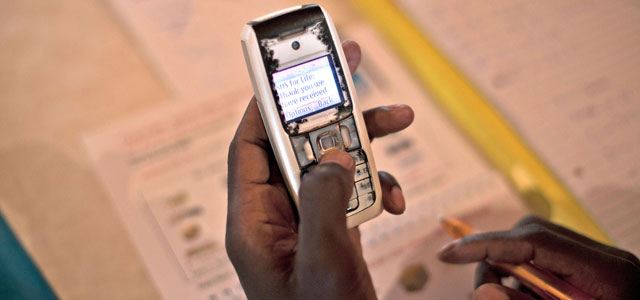“Mobile learning can help reach marginalized populations,” Vosloo said, giving as an example a library in Ghana that has no books on its shelves, but now has an e-reader, giving the students of that village access to hundreds of books that could never be physically sent to the library. That e-reader has opened the world to curious learners.
MOBILE LEARNING PROJECTS
In Nigeria, UNESCO is piloting a program with English teachers. Program leaders send messages daily with examples of how to teach English language to teachers throughout the country. The messages are formatted specifically for viewing on inexpensive devices common in Nigeria and are modular lessons. UNESCO has received feedback from participating teachers that the support is changing their teaching style and helping them to improve. It also allows teachers to share their learning with one another, previously very difficult to do between remote rural villages. An agreement with the mobile provider keeps costs for users low.
[RELATED READING: Library For All: Free Digital Content For Developing Countries]
UNESCO is also studying how the World Reader app has changed reading habits in the developing world, especially in places where many are illiterate. The organization interviewed 4,000 users and found that, in general, users are accessing and reading longer form content on their mobile devices. Detailed results of that study will be released in February.
“Many parents and teachers still think mobile learning and technology is not part of education,” said Vosloo. “[They think] they are more for distracting or disrupting, anything but learning.” UNESCO is working hard to change that perception and to help education departments to see mobile learning as an opportunity, not a threat. They advocate for clear policies set at the state or national level to guide mobile teaching practices. They’ve even written some guidelines to help governments set policy.
“It also sends out a clear message from leadership that, ‘we’ve considered mobile learning, we want to engage with it and these are the conditions in which it can happen,’” Vosloo said. The uncertain policy moment plaguing most of the world does not exclude the U.S. Districts are bringing tablets into the classroom or allowing student to bring their own devices, but haven’t always set clear policies. Some schools, recognizing the ubiquity of mobile devices, are taking their acceptable use policies and shifting them to become “responsible use” policies, trying to teach students how to use their technology respectfully.
[RELATED: How to Help Mobile Education Go Global]
Vosloo says even phones that only have texting (SMS) and calling functions can be useful for learning. “The main thing to remember is not that we’re going to deliver a whole textbook or learning experience by SMS,” he said. “The idea is what does SMS do well?” UNESCO has used texts to send reminders, for school administration purposes or to send small bits of content to students.
In one project focused on literacy for young women in Pakistan, students would travel to a central location for lessons in Urdu, then return to their remote villages for several weeks. The only way to reach them quickly was through text messages. “The biggest problem for new literates is forgetting what they’ve learned unless that knowledge is reinforced,” Vosloo said. Teachers texted reminders to the girls about reading and discussion assignments. “It played a very important role in that teaching and learning experiment,” Vosloo said.
Another program called BBC Janala in Bangladesh taught English to adults with audio. Students would call a number, listen to a three minute audio lesson and leave a message. The program used voice recognition software and texting for assessment. Again, a deal with the telecommunications provider kept the calls low cost.
Mobile technology is opening up creative ways for people around the world to learn from one another and the internet. In the U.S., school districts sometimes focus on glitzy devices and worry about giving students too much free access to the internet through their own devices. But perhaps there is a lesson from UNESCO’s global education work in recognizing the potential for reaching truly marginalized populations with fairly simple technology.


